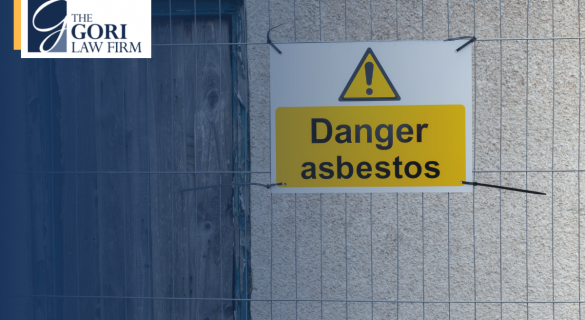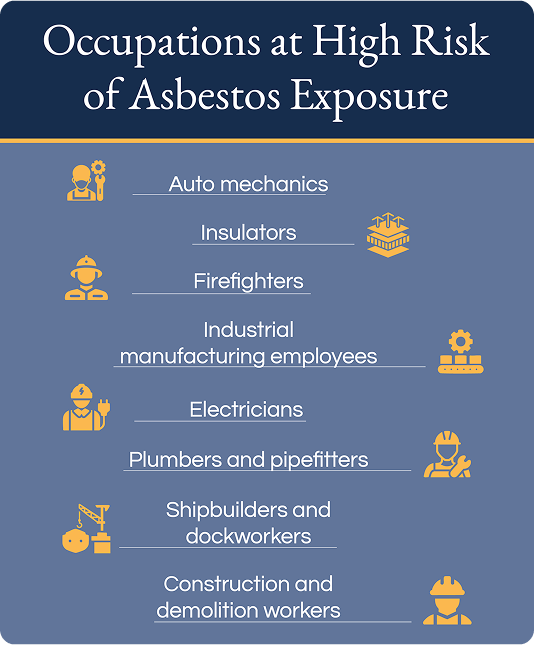Occupational Asbestos Exposure Statistics

Navigate this page
- What Is Occupational Asbestos Exposure?
- The Impact of Asbestos Exposure on Workers
- Occupational Asbestos Exposure Statistics
- Key Occupations at Risk for Asbestos Exposure
- Statistics for Respiratory Conditions and Diseases Linked to Asbestos Exposure
- Why Statistics Matter: The Need for Workplace Safety Regulations
- Legal Help for Workers Exposed to Asbestos
- Conclusion: Protecting Workers and Seeking Justice
- Frequently Asked Questions
- Additional Resources
- Millions of workers around the world have been exposed to asbestos, including those in industries such as construction and shipbuilding.
- Ninety percent of cases of mesothelioma deaths can be tied to workplace exposure.
- It can take decades for conditions such as mesothelioma or asbestosis to appear, making it challenging to tie exposure to a specific location.
- Legal compensation may be available to those who are diagnosed with asbestos-related illnesses.
Occupational asbestos exposure statistics reveal an alarming truth: Asbestos is still impacting people’s lives today. Unfortunately, many people in the U.S. workforce are exposed to asbestos, even though there are controls in place to help prevent it.
According to the Centers for Disease Control and Prevention, close to
1.3 MILLION
U.S. workers remain at risk of being exposed in construction and general industry.
For those who are exposed to asbestos fibers, there is a heightened risk of developing asbestos-related diseases, such as mesothelioma or asbestosis. These diseases can take many years to appear, making it difficult to link the disease to a specific source. However, with good legal representation and a strong case, it is possible to seek compensation for exposure to this dangerous mineral.
What Is Occupational Asbestos Exposure?
Occupational asbestos exposure happens when you inhale or ingest asbestos fibers during the course of the workday. Asbestos, which is a naturally occurring mineral, can release small fibers into the air when disturbed. Those tiny fibers can become lodged in the abdomen, esophagus, lungs, or other parts of the body, which can lead to significant health problems many years later.
Although there are regulations to protect workers from asbestos today, many still remain at risk because of the presence of asbestos in older buildings, industrial equipment, and materials.

The Impact of Asbestos Exposure on Workers
Asbestos was used across many industries throughout the 20th century; workers were exposed to it in places such as automotive plants, railroads, construction sites, and shipyards. Today, if you work in similar trades, you could also have been exposed (or have the potential to be exposed) to items containing asbestos.
The Centers for Disease Control and Prevention estimates that these occupations are at the highest risk of exposure:

In addition to exposure in the workplace, workers can also inadvertently bring asbestos fibers home on their clothing, potentially exposing their family members to the fibers, as well. For this reason, not all people who develop mesothelioma or other asbestos-related illnesses worked in the industries listed above, but many have links to them.
Occupational Asbestos
Exposure Statistics
Occupational asbestos exposure statistics show that there is a widespread danger of being exposed to asbestos in the workplace.
In the United States, asbestos use has declined. Despite this, occupational asbestos exposure rates are still a significant concern. The CDC’s Malignant Mesothelioma Mortality report showed that:
2,500 to 3,000 Americans
are diagnosed with mesothelioma annually.
Key Occupations at Risk for Asbestos Exposure
Many occupations are still at risk for asbestos exposure today, even though asbestos use has been reduced overall. Most occupational exposures in the United States now happen during the renovation, repair, removal, and maintenance of asbestos-containing products that had been installed many years ago.
These legacy asbestos-containing products continue to cause issues today, and the Occupational Safety and Health Administration estimates that 1.3 million employees working in construction and general industry end up exposed to asbestos while performing tasks such as those above.
The CDC also points out that some jobs have a historically higher risk of asbestos exposure in the workplace, including:
- Shipyard workers: These workers may be exposed while constructing or deconstructing ships.
- Firefighters: Firefighters may be exposed to asbestos during building fires.
- Electricians and pipefitters: Electricians and pipefitters may be exposed while working on old buildings or pipework.
- Mechanics: These individuals may be exposed to asbestos when working on vehicles, particularly during clutch and brake repairs.
- Industrial machine operators: These operators may be exposed to asbestos when materials with asbestos are made, cut, or disposed of.
- Construction workers: Construction workers may be exposed to asbestos while working with building materials, particularly when they are working in older buildings.
Statistics for Respiratory Conditions and Diseases Linked
to Asbestos Exposure
Asbestos-related disease statistics show that there are long-term risks associated with workplace exposure to asbestos. Illnesses that can be caused by exposure to asbestos include:

Lung cancer
Typical Exposures:
- Large cumulative exposure, which can be from short-term, high-level exposures or long-term, moderate-level exposures.
Latency Periods:
- Typically 20-30 years.
Clinical Presentation:
- 5%-15% of patients are asymptomatic at diagnosis.
- Most patients present with cough, hemoptysis, wheeze, or dyspnea.
Co-morbid Conditions:
- Asbestosis and other asbestos-related diseases.
- Paraneoplastic syndromes associated with lung cancer.
Mortality:
- Same as lung carcinoma with other causes: 14% five-year survival rate
Pleural plaques and effusions
Pleural Plaques:
- Typical Exposures: Can occur with both short low-level and high-level occupational exposures.
- Average Latency Period: 20-30 years.
- Co-morbid Conditions: Indicates asbestos exposure, increasing the risk of other asbestos-related diseases.
Mortality and Morbidity:
- Not fatal.
- Usually asymptomatic; incidental finding.
Pleural Effusions:
- Typical Exposures: Usually linked to moderate- to high-level asbestos exposures. Less specific than pleural plaques.
- Average Latency Period: 10 years.
- Co-morbid Conditions: Other asbestos-related diseases.
Mortality and Morbidity:
- Not fatal.
- Can range from asymptomatic to pleuritic chest pain and fever.
Diffuse Pleural Thickening:
- Typical Exposures: Can result from both occupational and environmental asbestos exposures, but also has other causes.
- Average Latency Period: 15 years.
- Co-morbid Conditions: Other asbestos-related diseases.
Mortality and Morbidity:
- Not fatal.
- If severe, can cause dyspnea.
- Usually no significant functional impairment unless very extensive.
Rounded Atelectasis:
- Typical Exposures: Follows non-malignant pleural effusions and can co-exist with other asbestos-related diseases or causes.
- Average Latency Period: N/A.
- Co-morbid Conditions: Can follow non-malignant pleural effusions; may co-exist with other asbestos-related diseases.
Mortality and Morbidity:
- Not fatal.
- Usually asymptomatic; if severe, can cause chest pain, dyspnea, and cough.
- Usually no significant functional impairment unless accompanied by other asbestos-related diseases.
Asbestosis
Sufficient Exposures: Typically linked to high-level occupational asbestos exposure.
Latency Periods:
- Radiographic changes: usually <20 years.
- Clinical manifestations: typically appear 20-40 years after exposure.
- Occurs earlier in those with higher exposure levels.
Risk of Asbestosis:
- Develops in approximately 50% of adults with occupational asbestos exposure.
Co-morbid Conditions
- Increased risk for asbestos-related lung cancer and mesothelioma.
- These conditions can occur without asbestosis..
Mortality and Morbidity:
- Severe asbestosis may result in respiratory failure over 1-2 decades.
- Leading causes of death:
- Asbestos-associated lung cancer: 38%
- Mesothelioma: 9%
- Other causes: 32%.
Malignant mesothelioma
The primary risk factor for developing mesothelioma is exposure to asbestos, according to the CDC. While that’s serious, there is an additional complication. The latency period—the time it takes before you begin to show symptoms of mesothelioma or other asbestos-related diseases—can be anywhere from 20 to 50 years. That delay makes it very difficult to detect mesothelioma or other illnesses in their early stages.
Typical Exposures:
- Short-term, high-level exposures or chronic low-level exposures, especially to amphibole asbestos.
- Incidence increases in a dose-related manner.
Latency Periods:
- Ranges from 10 to 57 years, with 30-40 years being typical.
Clinical Presentation:
- Often presents with chest pain, accompanied by a pleural mass or pleural effusion visible on chest radiographs.
Mortality:
- High mortality.
- Typical 1-year survival rate: <30%.
- Median survival time after diagnosis: 8-14 months.
Why Statistics Matter: The Need for Workplace Safety Regulations
Knowing how asbestos affects people like yourself matters when addressing workplace safety regulations. Asbestos statistics play an important role in shaping how public policy, OSHA standards, and business rules and regulations impact workers and the public.
The data signifies that there is a continued need for strong OSHA and Environmental Protection Agency guidelines. Additionally, asbestos exposure could be reduced or greatly impacted by:
- Requiring regular inspections of job sites
- Providing education and building awareness in high-risk sectors
- Updating safety training
- Improving safety equipment to protect against asbestos exposure
Occupational asbestos exposure statistics help demonstrate that legal protections are in place and that businesses may be liable in the case of exposing their workers.

Legal Help for Workers Exposed to Asbestos
For workers who have been exposed to asbestos, there is legal help available. If you or someone you love has been diagnosed with mesothelioma or another asbestos-related illness, you may have legal options open to you, such as:
- Filing a claim to recover damages such as lost wages, pain and suffering, and medical expenses
- Seeking compensation through asbestos trust funds
- Filing lawsuits against negligent employers or manufacturers
Conclusion: Protecting Workers and
Seeking Justice
Occupational asbestos exposure statistics make it clear that people’s lives are still impacted by asbestos exposure today. Even though asbestos exposure is preventable, tradespeople, workers in older facilities, and those who are retired from at-risk roles may have been exposed to asbestos and have the right to make a claim for mesothelioma compensation.
Frequently Asked Questions
How many people are exposed to asbestos in the workplace?
Experts believe that an estimated 1.3 million U.S. workers are potentially exposed to asbestos each year. Manual workers in the construction industry are more likely to be exposed than some in other industries.
What are the most common diseases caused by asbestos exposure?
Some of the most common diseases caused by asbestos exposure include mesothelioma, lung cancer, asbestosis, laryngeal carcinoma, and asbestos-related pleural abnormalities.
Which industries have the highest rates of asbestos exposure?
In the past, asbestos exposure occurred mainly in mining and milling raw materials. This happened in construction and product manufacturing.
How can I get compensation for asbestos exposure?
If you or a loved one is diagnosed with mesothelioma or another asbestos-related illness, then you may qualify for financial compensation by making a workers’ compensation claim, seeking compensation through an asbestos trust fund, or by filing a lawsuit.
Additional Resources
Want to learn more about asbestos, mesothelioma, asbestosis, and other related topics? Visit these helpful websites:

